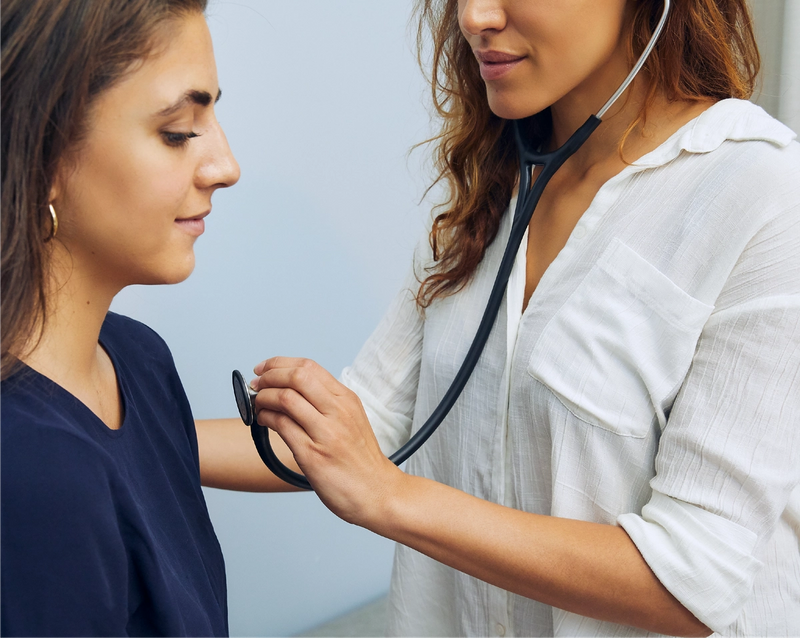What All Women Should Know About the Environmental Risks That Affect Pregnancy

With the physiological and hormonal changes that come with pregnancy, pregnant women face many new challenges with their health. That’s why routine appointments, screenings, blood tests and ultrasounds are done throughout every trimester until birth.
For instance, genetic screenings scan for mutations in your DNA, which could make your baby more prone to developing certain health conditions. And urine analyses check for glucose and protein , which can indicate gestational diabetes and preeclampsia. But oftentimes, little attention is given to the environmental risk factors that affect pregnant women.
“Women generally have healthy pregnancies, but growing research shows that climate change can create or worsen environmental hazards that threaten the health of pregnant women and increase health risks for the baby, such as low birth weight or preterm birth,” says former Parsley clinician Elizabeth Milbank, MD, MPH, a board-certified preventive medicine and lifestyle medicine physician. “A growing body of research has demonstrated a link between pregnant women exposed to high temperatures or air pollution and babies, who are premature, underweight or stillborn.”
The environmental risk factors of pregnancy
A recent systematic review in JAMA Network Open outlines the latest research that links air pollution and heat exposure related to climate change with preterm birth, low birth weight and stillbirth. The review of 57 studies found that low birth weight may be associated with fetal exposure to air pollutants, as well as inflammation from oxidative stress and altered heart and lung functions in mothers.
“Climate change worsens air quality because warming temperatures make it easier for ground-level ozone to form, and we know that exposure to two types of pollution: smoke (ozone) and tiny particles called PM 2.5 are associated with preterm birth, low birth weight, and stillbirth,” Dr. Milbank says.
FYI, ozone is a highly reactive gas that is both natural and man-made and occurs in the Earth’s upper and lower atmospheres, according to the Environmental Protection Agency . While ozone absorbs UV light and helps reduce your exposure to the sun’s harmful UV rays , when ozone is inhaled, it can pose health risks, specifically respiratory issues. These negative health effects include inflammation in the airways, cough, throat irritation, chest tightness, and shortness of breath. And when breathing is hindered, it can negatively affect pregnant women, who may already have shortness of breath due to hormonal changes.
Research has also shown that heat exposure can impair fetal growth by reducing uterine blood flow and may also contribute to prematurity from dehydration, according to an August 2017 study in theInternational Journal of Environmental Research and Public Health .
In addition, Dr. Milbank says that severe weather events, like wildfires, heat waves, and hurricanes can expose pregnant women to environmental hazards. “Wildfires increase the amount of pollution, dust, and smoke in the air. Extreme heat events can lead to dehydration and kidney failure in pregnancy, which by extension, can affect the baby’s growth and development,” Dr. Milbank says.
Moreover, hurricanes and floods can damage homes and communities, increasing exposure to toxins and mold and diarrheal illness from contaminated water and food supply. In fact, 2007 research published in Maternal and Child Health Journal found that approximately 56,000 pregnant women and 75,000 infants were directly affected by Hurricane Katrina in 2005, cutting off their access to clean water, safe food, and proper healthcare. It also exposed them to environmental toxins, such as carbon monoxide from improper use of devices powered by liquid fuels and natural gas.
This has led to pregnancy complications, like intrauterine growth restriction and decreased birth weight. Research from this study has also shown that women living in regions affected by hurricanes are at greater risk of not being able to breastfeed their baby or shortening their breastfeeding period compared to other women.
Why Black mothers are the most vulnerable to environmental risks
While these environmental risk factors affect all pregnant women, Black mothers are disproportionately affected and are at the highest risks for these pregnancy complications. June 2017 research in Environmental Health Perspectives , which looked at over 200,000 single births from 12 US cities, found that women exposed to cold and hot weather extremes were associated with stillbirth risk. Those stillbirths were more common among Black women and those with hypertensive disorders in pregnancy. Moreover, a September 2012 study in the American Journal of Public Health reveals that the fetal death rate is much higher among Black and Hispanic women than white women.
“New research is indicating that Black women and babies may be harmed by climate change and environmental hazards at a much higher rate than the population at large,” Dr. Milbank says. “Minority communities are disproportionately affected by pollution and global warming because they are more likely to be living in communities that are hotter than surrounding areas and may have less consistent access to air conditioning.”
Underserved and underrepresented communities are also less likely to live in neighborhoods with access to more green spaces and parks, and are more likely to live near power plants, bus depots, and other polluting industries, Dr. Milbank says. This can heighten environmental risks that are already high due to climate change.
“They may also have inadequate access to medical care and enter prenatal care at a later stage in the course of pregnancy, losing out on the critical guidance and support in the early days of pregnancy that might help mitigate some of these risks,” she says. “All of this adds to the already significant health burden faced by Black women in this country, who are two to three times more likely to die from pregnancy-related causes than white women.”
These health risks aren’t subjected to one generation either. Dr. Milbank says there’s growing evidence that these prenatal environmental exposures to endocrine disruptors and other environmental chemicals can adversely affect development in childhood, adulthood, and future generations.
“Observations from the Barker Hypothesis and the Dutch Hunger Winter show that intrauterine growth restriction, low birth weight and premature birth—the same adverse outcomes of climate change and environmental hazards—have a causal relationship with origins of hypertension, coronary artery disease, and diabetes in middle age,” Dr. Milbank explains.
How to reduce your environmental risks during pregnancy and beyond
While access to proper healthcare, good nutrition, and safe water are systemic issues that require a collective effort from our government and society as a whole to fix, there are steps you can take to be a better health advocate for yourself—and it starts with finding a doctor that will help you meet your individual needs.
It’s rare for many doctors to take such a conscientious look at your entire lifestyle and the environment in which you live, but at Parsley Health, members get more than just the 20-minute pep talk and blood work. To start, being a Parsley member means you’ll take an extensive questionnaire about every facet of your life, from the circumstances around your own birth to what you currently do for a living and how you manage stress.
“One of the greatest features of the Parsley membership is the amount of time we have to spend with our patients,” Dr. Milbank says. “We do a lengthy intake with each of our members that allows for an in-depth discussion of every part of our members’ lives—past medical and environmental history, discussion around the home and occupational environment that may put a woman at risk of environmental exposure.”
This information allows Parsley Health doctors to understand what has shaped the health conditions and lifestyle you have today, and how these events in your life play a role in how well you feel.
From there, your Parsley doctor will conduct extensive testing that goes beyond traditional bloodwork and looks for nutritional deficiencies , heavy metals and genetic implications, like MTHFR , Dr. Milbank says.
“We do extensive nutritional counseling around fish and vegetable consumption and help patients understand how to select low-mercury seafood and minimize exposure to pesticides. We also counsel our patients on basic foundational lifestyle principles, like sleep hygiene, stress management, and how to optimize exercise,” she says. By making these changes to your lifestyle, you can help minimize environmental hazards from climate change that can be harmful in pregnancy.
Other environmental factors to consider are your exposures to toxic chemicals from cleaning supplies, beauty products, and pesticides, many of which are considered endocrine disruptors .
“Minorities and communities with lower socioeconomic status may be disproportionately exposed to these toxins as well, having less financial freedom to remediate the home environment, choose organic fruits and vegetables, clean beauty and cleaning products, purchase safer kitchen tools, expensive water filters, and air purifiers,” Dr. Milbank says.
That said, even if you’re able to choose one of the lifestyle changes below recommended by Dr. Milbank, you’ll minimize your environmental risks.
Adopt an anti-inflammatory diet.
Whether you’re able to buy organic produce or not, the more important thing is to get more vegetables and fruits into your diet. Think leafy greens, such as spinach and kale, starchy vegetables like sweet potatoes and berries. That said, if you’re deciding which vegetables and fruits you should consider buying organic, reference the Environmental Working Group’s Dirty Dozen and Clean 15 lists. You also want to consider eating more fatty fish, such as salmon, tuna and cod. “Fatty fish are high in omega-3 fatty acid DHA, which is fundamental to both mom and baby’s brain health. Some plant-based sources of omega-3 fatty acids include chia and flax seeds, walnuts and pumpkin seeds.
Stay hydrated.
Drinking enough water not only helps your body perform everyday functions, but when you’re pregnant, your blood volume increases by at least 50 percent to support the growing baby, so make sure to drink enough water, Dr. Milbank says. Water is also necessary for staying regular (constipation is common during pregnancy thanks to higher progesterone levels), absorbing nutrients and transporting vitamins, minerals and hormones to blood cells.
Avoid fish high in mercury.
To reduce your exposure to heavy metals , avoid choosing seafood high in mercury, like shark, king mackerel and tilefish. Dr. Milbank suggests following the National Resources Defense Council’s guide to buying seafood to select fish low in mercury.
Get rid of cleaning and beauty products with harmful chemicals.
Dr.Milbank recommends avoiding cleaning and beauty products that contain phthalates, parabens, oxybenzone, BPA, and BPS. Check out the Environmental Working Group’s Skin Deep list of approved skincare brands and personal care products for you and your baby.
Minimize exposure to plastics.
Plastics contain endocrine-disrupting chemicals , Dr. Milbanks says. Use water bottles and food containers made with aluminum or glass.
Reduce exposure to pollution when possible.
Dr. Milbank recommends exercising in green spaces and avoiding walking in areas that are highly polluted. You should also limit outdoor exercise when air quality is poor.
Tiffany Ayuda is a New York City-based editor and writer passionate about fitness, nutrition, health, and wellness. She has held previous editorial roles at Prevention, Eat This, Not That, Daily Burn, and Everyday Health. Tiffany is also a certified personal trainer through the American Council on Exercise. When she's not writing or breaking up a sweat, Tiffany enjoys cooking up healthy meals in her Brooklyn kitchen.
Get a snapshot of your health - right now.
Take our quiz to get your symptom score and start uncovering the why behind your symptoms.
WHAT IS PARSLEY HEALTH?
Our leading medical providers and health coaches heal the root cause of health concerns with a personalized care plan and year-round support. Our root-cause resolution medicine has helped thousands feel better, with 85% of members reducing symptoms in their first year.

